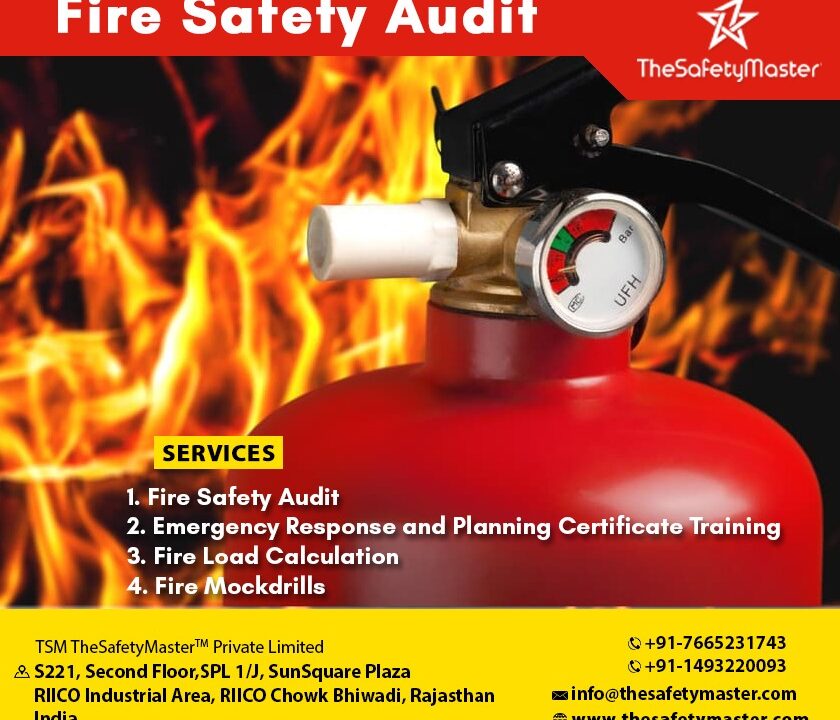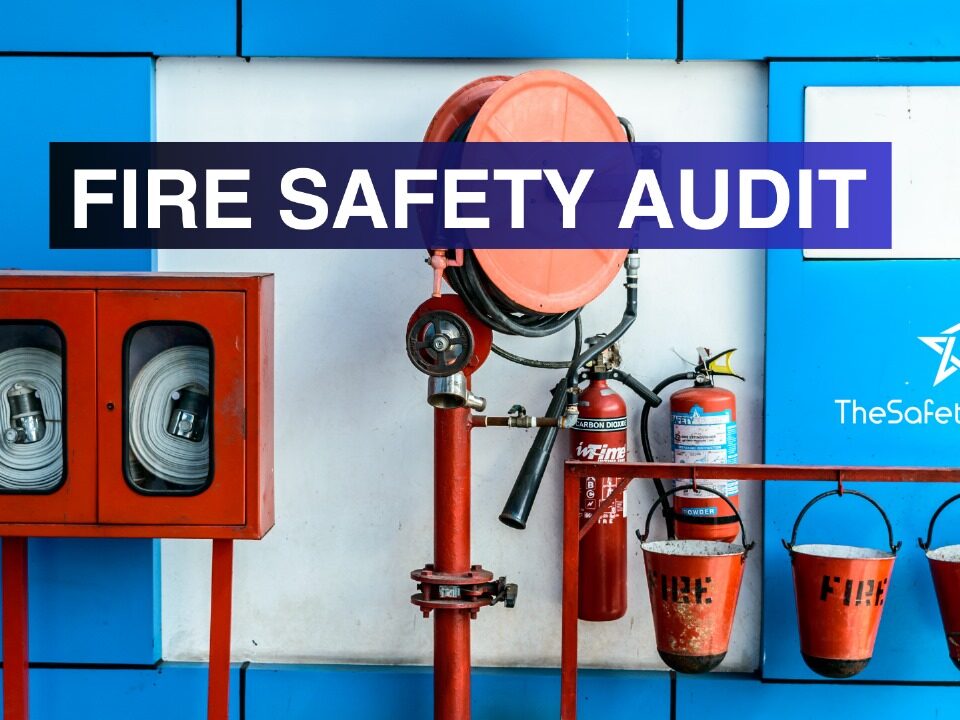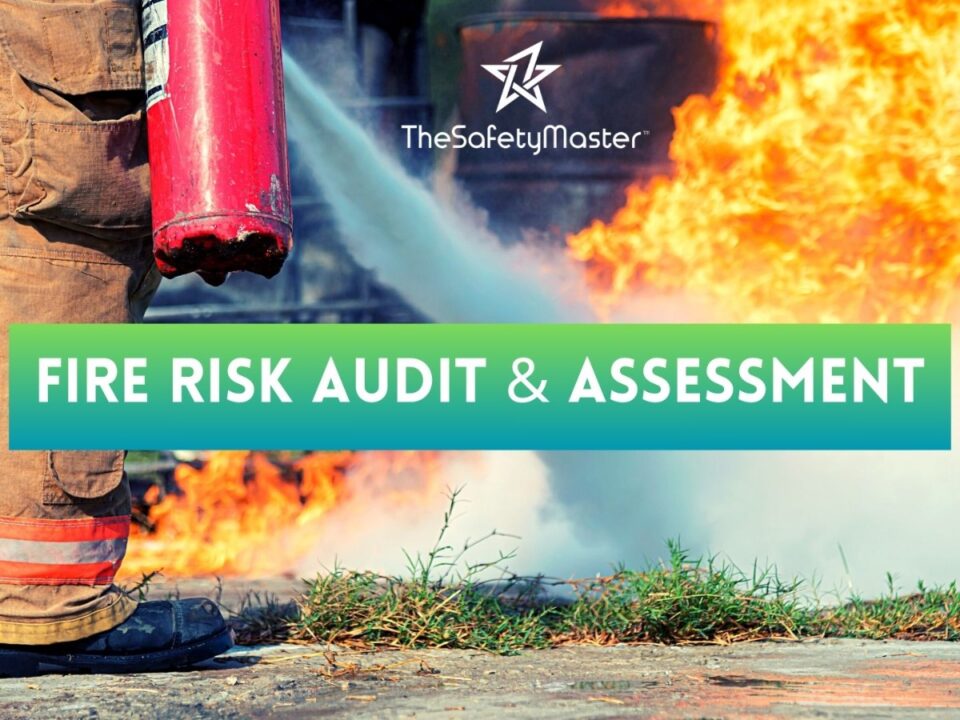Fire Safety Audits: A Crucial Aspect of Risk Management for Indian Industrial Facilities

Effective Safety Communication: Using Safety Quotes, Slogans, and Messages to Inspire a Safer Workplace
September 18, 2024
Keeping the Sparks at Bay: How Fire Safety Audits Are Revolutionizing Safety Standards in the Electric Vehicle Manufacturing Sector
October 3, 2024In this article, we delve into a critical aspect of risk management for Indian industrial facilities: fire safety audits. With fire incidents posing an ever-present threat to the safety of personnel and property, it becomes paramount for organizations to proactively identify and address potential fire hazards. We shed light on the importance of these audits, their role in mitigating risks, and the key components involved. By the end, you will have a comprehensive understanding of how fire safety audits can safeguard your facility, streamline operations, and ensure compliance with stringent regulations. Be prepared to equip yourself with invaluable knowledge that could save lives and livelihoods. Buckle up!
Introduction
Fire incidents in industrial facilities pose a significant threat to life, property, and the environment. The rapid industrialization witnessed in India over the past few decades has led to an increase in the number of such incidents. This highlights the urgent need for effective risk management measures, with fire safety audits emerging as a crucial aspect of ensuring the safety of Indian industrial facilities. In this article, we will delve into the world of fire safety audits and explore their significance in mitigating risks associated with fire incidents. We will dissect the regulatory framework governing fire safety audits in India and understand the role played by fire safety auditors. Additionally, we will uncover the benefits that come along with conducting regular fire safety audits and discuss key elements involved in these inspections
Importance of Risk Management for Indian Industrial Facilities
The importance of risk management for Indian industrial facilities cannot be overstated. With the rapid growth of manufacturing and industrial sectors in India, it is essential to prioritize safety measures to protect both human lives and valuable assets. By implementing robust risk management practices, industrial facilities can identify potential hazards, assess their likelihood and impact, and take proactive steps to mitigate them. Indian industrial facilities often operate in complex environments that involve various processes, machinery, chemicals, and human resources. These factors increase the potential for accidents or disasters that can have far-reaching consequences. Effective risk management helps identify vulnerabilities and implement preventive measures to minimize the likelihood of incidents occurring.
Moreover, risk management also plays a crucial role in safeguarding the reputation and financial stability of Indian industrial facilities. By proactively addressing risks through comprehensive strategies, organizations can build a strong foundation for sustainable growth. This not only instils confidence among stakeholders but also attracts investments and promotes long-term business viability.
In conclusion, prioritizing risk management within Indian industrial facilities is imperative for ensuring the safety of individuals, protecting assets, maintaining business continuity, and enhancing overall productivity. By actively identifying potential risks and implementing appropriate measures to mitigate them through comprehensive strategies like fire safety audits, industries can create a secure environment that fosters growth and prosperity.
Understanding Fire Safety Audits
Understanding Fire Safety Audits: Fire safety audits are a systematic evaluation of fire prevention, protection, and emergency response measures implemented in industrial facilities. These audits aim to ensure compliance with fire safety regulations and identify potential risks or vulnerabilities that could lead to a fire incident. By examining various aspects such as building design, active and passive fire protection systems, emergency evacuation procedures, and training of personnel, fire safety audits provide an essential tool for effectively managing the risk of fires in Indian industrial facilities.
Consider the scenario where an industrial facility has recently undergone significant changes in its operations or infrastructure. An understanding of fire safety audits would reveal that conducting a comprehensive audit is crucial to assess the adequacy of existing fire protection measures and identify areas requiring improvement. This proactive approach not only mitigates potential dangers but also instils confidence among employees and stakeholders by demonstrating the organization’s commitment to their well-being.
Fire safety audits empower businesses by providing valuable insights into their existing fire safety preparedness levels. Implementing the recommendations derived from these audits can lead to enhanced operational efficiency, reduced insurance premiums, increased employee morale, and strengthened public trust in the facility’s commitment towards safety. Understanding the significance of fire safety audits equips organizations with knowledge that can help them stay ahead of risks while creating a safer work environment for everyone involved.
Regulatory Framework for Fire Safety Audits in India
The regulatory framework for fire safety audits in India is a comprehensive system aimed at ensuring the safety and well-being of individuals working in industrial facilities. The National Building Code (NBC) provides the basis for fire safety regulations, outlining the requirements and guidelines that must be adhered to by industrial establishments. Additionally, each state in India has its own set of rules and regulations pertaining to fire safety audits, which further strengthens the regulatory framework. Under the NBC, it is mandatory for industrial facilities to obtain a no-objection certificate (NOC) from the local fire department before commencing operations. This certificate is granted after a thorough inspection and assessment of the facility’s fire safety measures. These measures include elements such as proper installation and maintenance of firefighting equipment, adequate access and egress routes, appropriate storage of hazardous materials, and clear signage indicating emergency exits.
The optimistic spin on this regulatory framework lies in its commitment to creating a safer working environment for individuals employed within Indian industrial facilities. By enforcing strict guidelines through mandatory fire safety audits, the government aims to prevent accidents caused by fires or related emergencies. This proactive approach not only protects human lives but also ensures that businesses can operate smoothly without disruptions caused by preventable incidents.
Role of Fire Safety Auditors in Risk Management
In the intricate realm of risk management, fire safety auditors play a vital role in safeguarding Indian industrial facilities. These diligent professionals possess an innate ability to identify potential fire hazards, evaluate existing safety measures, and propose effective solutions to mitigate risks. By utilizing their expertise and comprehensive knowledge of fire safety codes and regulations, they help organizations ensure compliance and create a safer working environment for employees. Fire safety auditors act as catalysts for positive change within industrial facilities by conducting thorough assessments of infrastructure, processes, and systems. They meticulously examine various aspects such as emergency evacuation plans, fire detection systems, sprinkler installations, electrical wiring standards, and storage practices. By scrutinizing these critical elements, auditors can pinpoint vulnerabilities and provide recommendations that enhance the overall fire safety preparedness of the facility.
Moreover, these auditors also educate facility management personnel on fire prevention techniques and best practices. They raise awareness about potential hazards and train employees on proper use of firefighting equipment. Through their proactive approach towards risk management, fire safety auditors empower organizations to take proactive measures that not only comply with regulatory requirements but also instil confidence in employees regarding their safety at work. Their diligent efforts contribute towards creating a harmonious work environment where individuals can thrive without fear or apprehension.
Benefits of Conducting Regular Fire Safety Audits
Benefits of Conducting Regular Fire Safety Audits: Regular fire safety audits offer a multitude of advantages for Indian industrial facilities. Firstly, they ensure compliance with regulatory standards, enhancing the overall safety culture in the workplace. By identifying potential fire hazards and implementing necessary preventive measures, audits significantly reduce the risk of fire incidents, minimizing property damage and potential loss of life.
Furthermore, conducting regular fire safety audits allows organizations to stay proactive in their risk management strategies. It enables them to identify areas that require improvement and helps develop robust emergency response plans. This proactive approach not only enhances the safety of employees but also boosts the confidence of clients and stakeholders in the facility’s commitment to maintaining a secure working environment.
Moreover, regular audits provide an opportunity for continuous learning and improvement. Through comprehensive assessments, organizations can identify patterns or recurring issues related to fire safety and take appropriate corrective actions accordingly. This iterative process ensures that fire prevention measures are regularly reviewed and updated, leading to enhanced efficiency and effectiveness over time.
In summary, regular fire safety audits not only fulfil legal obligations but also foster a proactive safety culture within Indian industrial facilities. They mitigate risks effectively by identifying potential hazards before they escalate into emergencies while providing an avenue for ongoing improvement in fire prevention practices.
Key Elements of a Fire Safety Audit
Key Elements of a Fire Safety Audit:1. Comprehensive Hazard Identification: A crucial element of a fire safety audit is the identification and assessment of potential hazards within an industrial facility. This includes examining the building’s layout, electrical systems, storage areas, machinery, and other equipment for any fire-related risks. By conducting a thorough analysis, auditors can pinpoint potential ignition sources and fuel loads, assisting in the development of effective risk mitigation strategies.
2. Adequate Fire Protection Measures: Another key element is evaluating the existing fire protection measures implemented in the facility. This involves assessing the functionality and maintenance of fire alarms, sprinkler systems, extinguishers, hydrants, evacuation routes, and emergency lighting systems. Auditors scrutinize these elements to ensure they comply with relevant regulations and are capable of effectively combating fires should they occur.
3. Emergency Preparedness Planning: A comprehensive fire safety audit also examines the preparedness level of the facility in responding to emergencies. This includes evaluating emergency response plans, employee training programs on evacuation procedures and proper use of firefighting equipment if necessary. Assessing communication protocols during emergencies is also crucial in order to coordinate efforts efficiently and minimize potential losses.
By addressing these key elements within a fire safety audit process comprehensively, Indian industrial facilities can enhance their overall risk management strategies while creating safer working environments for their employees. The implementation of effective preventive measures not only reduces the likelihood of fires but also instils confidence among stakeholders that safety remains a top priority within these facilities.
Steps Involved in Conducting a Fire Safety Audit
In order to conduct a comprehensive fire safety audit, several key steps need to be followed. The first step is to establish the scope of the audit, defining the specific areas and processes that will be evaluated. This ensures that all potential fire hazards are considered. Once the scope is established, the next step involves gathering relevant information about the facility, including architectural plans, fire protection systems documentation, and emergency response procedures. This information serves as a foundation for assessing existing measures and identifying potential gaps.
The third step is conducting a thorough on-site inspection. This involves physically examining all areas of the facility to identify fire hazards such as improper storage practices, inadequate ventilation systems, or outdated electrical wiring. It also includes evaluating the effectiveness of fire detection and suppression systems.
Following the inspection, it is crucial to analyse collected data and compare it against applicable regulations and industry best practices. This step helps identify non-compliance issues and areas where improvements can be made to enhance overall fire safety.
Lastly, based on the findings from the analysis stage, a detailed report should be prepared outlining recommendations for remedial actions. These recommendations may include upgrading fire protection systems, implementing training programs for employees on evacuation procedures or creating emergency response plans.
By following these steps meticulously, Indian industrial facilities can ensure that their fire safety audits are conducted with precision and efficacy. Ultimately, this will lead to improved risk management practices that will create safer work environments for all stakeholders involved.
Tools and Technologies for Effective Fire Safety Audits
Tools and Technologies for Effective Fire Safety Audits: Implementing effective fire safety audits requires the use of advanced tools and technologies that can accurately assess and mitigate risks. One such tool is the state-of-the-art fire alarm system, equipped with intelligent sensors and detectors capable of detecting even the slightest signs of smoke or heat. These systems are designed to provide real-time alerts, enabling swift response to potential fire incidents.
Additionally, thermal imaging cameras play a vital role in identifying hidden sources of heat within industrial facilities. By capturing thermal images, these cameras enable auditors to pinpoint potential fire hazards that might go unnoticed by traditional inspections. This technology empowers auditors to take proactive measures before a hazardous situation escalates.
Furthermore, integrating computer-aided evacuation simulation software aids in assessing the effectiveness of emergency evacuation plans. These programs allow auditors to simulate various scenarios, testing the efficiency of escape routes and identifying potential bottlenecks or shortcomings in existing plans. By employing such technologies, industrial facilities can bolster their risk management strategies and ensure the safety of their workforce.
Incorporating these tools not only enhances the accuracy and efficiency of fire safety audits but also instils a sense of confidence among facility owners and employees. Knowing that cutting-edge technologies are being utilized to identify risks provides reassurance that proactive measures are being taken to maintain a safe working environment.
Case Studies: Successful Fire Safety Audit Implementation in Indian Industrial Facilities
Case Studies: Successful Fire Safety Audit Implementation in Indian Industrial Facilities in the journey towards enhanced fire safety, several Indian industrial facilities have set exemplary benchmarks by successfully implementing fire safety audits. One such notable case study is of a leading pharmaceutical company located in Mumbai. With a commitment to prioritizing safety, they enlisted the expertise of certified fire safety auditors who meticulously assessed their facility’s fire protection systems and procedures. Through a comprehensive audit, potential risks were identified and rectified promptly, ensuring a robust fire safety management plan.
Another noteworthy case study is that of a large textile manufacturing unit situated in Gujarat. Recognizing the importance of proactive risk management, they conducted regular fire safety audits to evaluate their compliance with local regulations and industry standards. By engaging experienced auditors skilled in analysing complex industrial setups, they were able to identify shortcomings in their existing fire prevention measures and implement corrective actions promptly.
These successful case studies highlight the positive impact that thorough fire safety audits can have on industrial facilities in India. By investing in regular audits and working closely with competent professionals, these companies not only safeguarded their employees’ well-being but also protected valuable assets from potential fire hazards. Such examples inspire others within the industry to follow suit and prioritize risk mitigation through effective audit implementation.
Challenges and Best Practices for Fire Safety Audits in India
Challenges and Best Practices for Fire Safety Audits in India Navigating the realm of fire safety audits in India is not without its challenges. One of the major hurdles faced is a lack of awareness and understanding among industrial facility owners regarding the importance of fire safety audits as an integral part of risk management. Many businesses view it as a mere compliance requirement rather than a proactive measure to safeguard their employees and assets.
Another challenge lies in keeping up with the ever-evolving regulatory landscape. Laws and regulations surrounding fire safety audits are subject to periodic updates, making it crucial for auditors to stay abreast of these changes. Additionally, coordinating with multiple stakeholders – from facility managers to government officials – can sometimes be complex, leading to coordination issues during audit implementation.
Despite these challenges, there are best practices that can greatly enhance the effectiveness of fire safety audits in Indian industrial facilities. Firstly, fostering a culture of safety throughout the organization is essential. This can be achieved through regular training programs on fire prevention and emergency response procedures, ensuring that all employees are equipped with the knowledge to identify potential risks and respond appropriately.
Furthermore, adopting advanced technologies such as automated monitoring systems and smart firefighting equipment can significantly improve audit outcomes. These innovations enable real-time tracking of critical parameters like temperature, smoke levels, and sprinkler system performance, allowing for swift detection and response to potential fire hazards.
By embracing these best practices alongside an optimistic mind set towards proactive risk management measures like fire safety audits, Indian industrial facilities can create safer working environments while also promoting productivity and peace of mind for their workforce.
Conclusion
Fire safety audits play a vital role in ensuring the well-being of Indian industrial facilities and their occupants. By meticulously assessing fire risks and implementing effective preventive measures, these audits help mitigate potential disasters and save lives. While challenges exist, such as compliance issues and resource constraints, there is an encouraging trend towards greater awareness and investment in fire safety. With continued commitment to regular audits, embracing technological advancements, and sharing best practices, Indian industrial facilities can create safer environments that foster growth and prosperity for all stakeholders involved. So let us embrace the power of fire safety audits to build a brighter future for our industries.




